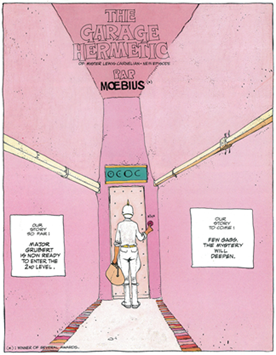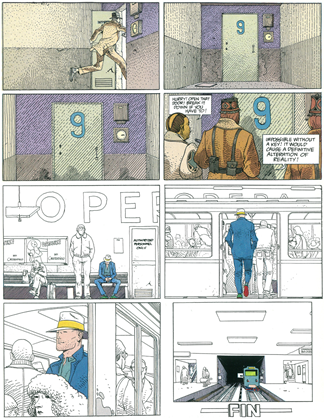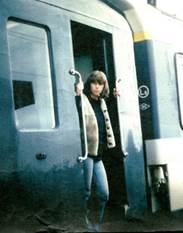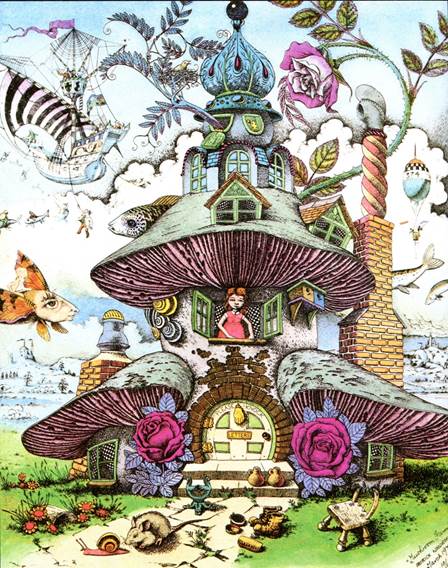CL Moore has a good definition of alternate realities in The Code (Golancz, Omnibus page 600)

Another good example is Moebius’s The Airtight Garage


..a door opens from the Airtight Garage to a subway and the guy disappears or becomes anonymous. Parallel realities are resolved space – like a railway junction – which we live in (science/Apollo, order).
In another CL Moore story, she says the universe has “ambiguous symmetry” and we rely on Fortune or the gods (horoscopes).
The Fortunate world is populated by nymphs and dryads who exist in irresolvable space: lifedeath, decay/rebirth. Byron said
Like Sylla, I have always believed that all things depend upon Fortune, and nothing upon ourselves. (Detached Thoughts..Collins page 675)
So, to Byron, Fortune is real in an unreal world (the opposite of modernity). That is the world we need to get back to. One way is through legend

The image of Perrine leaving on a train could be taken as her entering the parallel reality world (and disappearing – Tales of Faith)
Parallel realities are resolved space where fact becomes fiction (see passim) and we forget the classical ideal of proportion and balance. Artificial asteroid Cyrille, in CL Moore’s Judgement Night is the perfect illusion or "resolved space" where all the facts are illusory. Somewhere, the originals of this living reproduction had once walked hand in hand.. They might be cowering at this moment in some underground shelter.. But they walked here in an eternal moment of laughter and murmuring. (Golancz Omnibus page 477)
Heroine Juille penetrates to a green, “elemental undersea" scene where one of the customers is indulging in their private psychosis.
Juille's reason told her that she had stumbled into one of the darker levels of Cyrille.. This undulating reptilian horror must be one of the hopeless addicts, wealthy enough to indulge his madness even when civilization was crumbling outside the walls.. (page 484)
One might ask, why is civilization crumbling when people like Musk are ever-optimistic? Well, they are optimistic for a future of individuals who are happy to soak-up their new gadgetry, not nostalgic for a world of self-governing communes which, to them, is regressive. A lot of this comes into a bizarre sci-fi pulp called Venus Plus X (1962) by Theodore Sturgeon.

The cover was apparently the model for Nebulos, ST 162
What the book does is strip humanity of its interesting differences – racial, sexual – so you end up with a type of neutered sex between hermaphrodites. There is a Utopian aim to rid humanity of its murderous impulses, but it’s noticeable how cy the civilization is. They swipe everything in sight “sensory-style” (Amazon House) and have something called cerebrostyle that plugs into the brain.
The bizarre thing is, their religion is a paedophile’s dream of naked kids, but the sex-impulse has been magically “detached”. The human interloper, Charlie Johns, starts off enthralled but ends up: Charlie almost spit as he said, “..Men marrying men. Incest, perversion, there isn’t anything rotten you don’t do.” “Do you think,” said Mielweis courteously, “that your attitude is unusual, or would be if the bulk of mankind had your information?” “About a hundred and two percent unanimous,” Charlie growled. (page 152)
Now, according to Sturgeon, that is bigotry; I think it’s just honesty! Yes, we are a divided race and women have curves and men have shoulder-pads. By our differences shall we have affinities (see Howard P11). That is very Weird Tales and very human and introspective of the warrior and the monk. According to Sturgeon, “humanity” is everything but those things. Written in 1960, his bizarre neutering of social norms is getting more current by the day.
Mary has three brothers and we thought it would be lovely if one of them was willing to help us fulfil our dream. In the kindest and most generous gesture, the brother in question said yes (“I do”) And thanks to successful IVF treatment, I conceived Horatio, our son. (Mary Portas’s wife, DT)
There’s something odd here, if you think that our societies follow a Darwinian ideology yet couldn’t be less like a wilderness. Darwin is a Big Beast (often seen on English banknotes) but, as I always say, where are the real big beasts like the golden eagle?
They’re up on the hills in high aeries, eaglets secure in mother-love soaring on updrafts of lofty peaks; matriarchy and iconic power on the wing (Pictorial 5) “They” will say there is a vicious struggle going on and you shouldn’t believe the serene scene you’ve seen. That’s because they are infidels, non-believers in the fearful symmetry of nature. The iconic religiosity of life – conception, gestation and nesting, birth, mothering and wing-taking, the first kill – have completely nothing to do with struggle!
The reason we don’t see this is because generally speaking we are non-believers and instead believe in Anti-Life, the scientific worldview. The cathedral of geometric science – CERN – attracts our gaze, even though its hermetic doors don’t conCERN us, here in the organic world of the moment and the uplifted wing. In short, you have to believe in iconic power or you literally won’t see it. Hence, our lives will have no power (ontology) and, as for meaning (epistemology), Scientists aren’t interested in power and meaning, religiosity and iconography. They want us to fit the world they are building: survival of those who fit, the end of freedom, abysmal order triumphant, bits of consciousness run by the ubiquitous AI, cybergenome city, hyperloops galore, next stop, Mars (don’t bother, we’re here).
An eagle on the wing is not fit to survive, that’s completely the wrong way round. They are power incarnate souring on lofty thermals, grace and momentary twists and turns. Like a worm underground that twists in primal movement, the eagle overhead is in the moment. No calculation, no order, that is the nature of savage freedom. There are two universes; one is calculated and hermetic (see “The Airtight Garage”); the other can’t be calculated and is in the moment. One is a parallel reality of geometry, the other is tiered. One is psychic weakness, sameness; the other is the affinity of differences (Howard Pictorial 13)
People literally don’t see what they don’t believe. Awhile back I was talking about David Atten-bore’s wildlife docs and how their overload of animated information feeds us the idea of struggle, whereas another vison of nature is a serene dream (Pictorial 4). This may seem like a non-sequitur (surprise?) but Matt Groening’s The Simpsons is a descendent of Life is Hell. Why is life hell? Is it because our vision, our psyche, our dreams are pulverized by animated information of various types? A visionary dream symbolises the protective, matriarchal, iconic presence of natural forms. If you are fed facts all you will see are facts; the serenity, the religiosity, the lifecycle are lost.
Attenbore is just the descendent of Darwin and the “fact” of struggle. Then, we are fed the “fact” of working in a free-market, what the French call the “Anglo-market”. Isn’t it true we live in a factual world, as opposed to a visionary, symbolic, protective one? We believe in a factual world, and people don’t see what they don’t believe. We believe in Anti-Life. Here’s a quote from How the Two Ivans Quarrelled by Gogol. Ivan Ivanovitch’s house at Mirgorod
..pleases me because sheds and other little additions are built on it on all sides; so that, looking at it from a distance, only roofs are visible, rising one above another, and greatly resembling .. fungi growing on the trunk of a tree. Moreover, the roof is all overgrown with weeds; a willow, an oak, and two apple trees lean their spreading branches against it. Through the trees peep little windows with carved and white-washed shutters, which project even into the street. (Taras Bulba and other Tales, page190, Dent)
Dated roundabout 1820, before the vast machinery of Darwinian capitalism transformed life into a “comfort zone”.

Patrick Woodroffe, 1971
What has been lost of life’s true comforts?
Oh, if I were a painter I would describe the night’s charms! I would describe how all of Mirgorod sleeps; how steadily the myriads of stars gaze down upon it; how the apparent quiet is filled far and near with the barking of dogs; how the love-sick sacristan steals past them, and scales the fence with knightly fearlessness; how the white walls of the houses, bathed in the moonlight, grow whiter still, the over-hanging trees darker; how the shadows of the trees fall blacker, the flowers and then silent grass become more fragrant, and the crickets, unharmonious cavaliers of the night, strike up their rattling song in friendly fashion on all sides.. (page 208)
The ending of the story goes, “How tedious is this life.” Tedium is the one thing our comforts are supposed to replace. However, if tedium is true and the comforts false, what gain? We are being sold a sunlit falseness and not a true picture of night owls and willow-blossoms. Yes, tedium is abroad in the world and it is oft times a blessing of sombre lustre (Byron “almost longs for woe” Weird 11).
I’m not denying that the roaring twenties and the fascinating fifties are better than what we have now, only that it becomes ever-clearer Darwin is the kingdom of fact, and not of vision, psyche, dream.

“vanishing point” (Cosmic Curmudgeon)
The future ever-more resembles a hermetic, geometrical flatland because that is what the “facts” demand. If you believe the facts and not the picture-scapes that Gogol paints, that is what you will get. The universe we are in is “correct” for precise timing – a cy-verse. This applies to everything from Darwin to auto-manufacture. Like “The Airtight Garage there’s no escape except through another door which leads to another parallel reality (of generic sameness).
Darwin’s image casts a lengthy shadow, and we need other images, wiser, more ancient.
The more right his acolytes think they are the more wrong in reality, since they are simply amassing more facts which lead inevitably to a cy-future, where fact becomes fiction. One with the machine. What is lost is everything that is not factual, which is basically life itself. The reckless gambler, the vagabond, the lifecycle of a dream, intuitive mists, mystery, belief and faith.
Without faith one may as well be a mote on a hard-drive. Another of Gogol’s stories is The Mysterious Portrait, which casts a malevolent shadow over all who purchase it. One, a painter, joins a seminary and lives his days in penance until finally he is able to paint a holy image. Something wise, mysterious, rustic, living in the age-old cycles of nature. Wisdom is balance and a sense of proportion, the pure knight who fights dragon-fire (see Spenser and Noto)
Home







